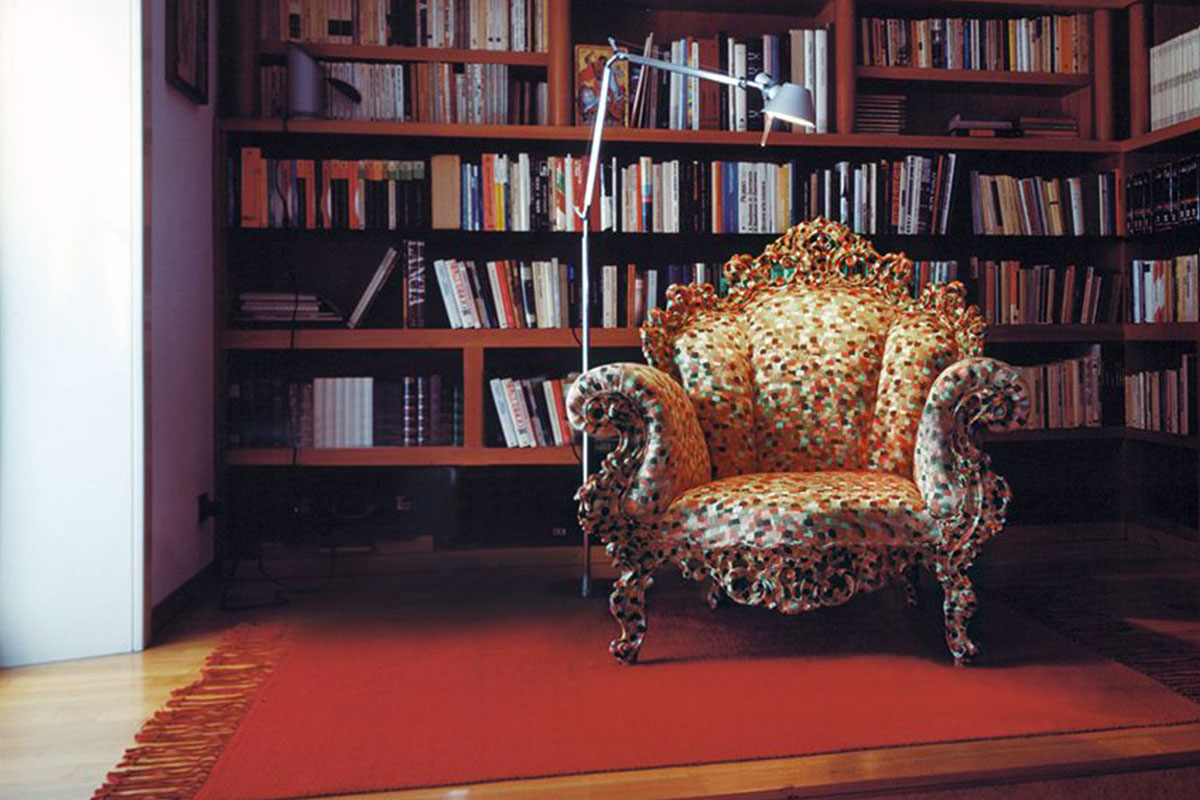Released in 1983 and reissued in 2019, the album is a collaborative work by Mendini with a collective of Italian alternative artists A rediscovery of the Italian master’s postmodernist legacy
Two years ago, on 18th February 2019, the Italian architect, designer, artist, critic, and theorist Alessandro Mendini left us. Born in Milan in 1931 and graduated from the Polytechnic of his city, he rose to the forefront of international criticism in the Seventies, remaining protagonist of many important cultural events of the last thirty years of the Twentieth century, also through theoretical contributions on the phenomena in progress and creating new schools of thought.
Mendini is associated with the theoretical foundation of postmodern design and some crucial concepts, such as those of banal design, which applies the category of banal as a linguistic code and which «admits quotation, incongruity, inauthenticity and incompleteness», and of re-design, which is based on decorative interventions on found objects or existing and well-known design products.
From architectural design to theory and criticism
He began his professional activity as a partner of Studio Nizzoli. But just from the beginning, he alternated it with a solid theoretical and critical commitment. As he said, with words clearly explaining his open vision. «As far as I am concerned, it is not design that interests me: I use design, not as a means to an end, but to carry out my natural vital role, which is to produce images».
Lively animator of radical design currents, Mendini founded and joined cultural movements and research groups, such as Global Tools in 1973 and Alchimia in 1979. Also a brilliant and prolific writer, he was founder and director of the design magazines Modo (1977-79) and Ollo (since 1988), and he also directed the two main Italian architecture magazines: Casabella (1970-76) and Domus (1979-85), initially called to fill the role by his mentor Gio Ponti, who was due to leave having reached the age limit.
Among his written works, the most celebrated have been Paesaggio casalingo (1979), Architettura addio (1981), Progetto infelice (1983), Existenz maximum (1990) and The international design yearbook (1996). As an architect and designer, he received many awards, including the Golden Compass (1979 and 1981) and the Architectural League honor (New York, 1983).
The Proust Armchair
In 1989 he founded (with his brother Francesco) Atelier Mendini, which collaborated with brands and companies such as Zanotta, Alessi, Swatch, Philips, Venni, Bisazza, and Cartier. In addition, he left his signature as an architect on the Groninger Museum (1988-1994, 2010), the Alessi factories and the Omegna Museum-Forum (1996), the theater called Teatrino della Bicchieraia in Arezzo, and the urban regeneration of the Maghetti district in Lugano (1998), the renovation of the Termini Station in Rome (1999), the restoration of the Villa Comunale (1999) and three stations of the Naples underground (2000), as well as on the new branch and exhibition space of the Milan Triennale in Incheon, South Korea (2008-2009).
His Proust Armchair, designed for Cappellini in 1978 and globally famous and celebrated, is defined by Mendini himself just as «an intellectual exercise». The chair’s name is a tribute to the French writer, and its design mixes a Baroque-style shape with a pattern of tiny hand-painted pointillist colored dots across its wooden frame and its upholstery, recalling Paul Signac’s painting technique. It is one of the best examples of Mendini counter-design, a sort of deeper reflection about the theme of re-design, which is also well explained in Originalità del falso (1997): «I both invent and copy, because in the pantheism of the enormous galaxy of merchandise, everything that I can imagine already exists. What is important is that my forgery is original».
The music project Architettura Sussurrante
Driven by his creative vitality, Alessandro Mendini explored different arts and disciplines with courage and intuitions. «My vision is to process images of any kind, architecture or design, or pictorial or sculptural, interacting with people in a poetic way. If my object finds its friend, it has played its role».
He did not neglect to venture into the musical field with the same intention. Mendini aspired to a total architecture capable of embracing people’s life and thinking; across his versatile research path, he experimented with the presence of a sound element, which is non just mere decoration but can be a constituent part of the architectural design itself.
In 1983 the Italian label Ariston, which was also promoting Donatella Rettore and Matia Bazar in the same years, published his Architettura Sussurrante, a sound experiment printed in a minimal number of copies and known almost only to professionals and collectors. Several years later, a few months after Mendini’s passing in 2019, Industrie Discografiche Lacerba reissued 300 copies of the work in transparent vinyl, along with cd and digital format for the download.
Whispering architecture
Architettura Sussurrante intended to detach design from its industrial and consumerist aspects. Mendini wrote about it: «If we close our ears to the walls of a room, they tell us their message, their whispering architecture, the dirge accumulated by the generations that have had life and death, joy and pain within those walls. This is the meaning of the collection of songs, dictions, and noises on this record».
This album, both in the original version and in the recent reissue, is a sort of lock pick that unhinges prejudices and conventions, opening different suggestions in many dimensions: music and design, of course, art, culture, history, sociology, anthropology, fashion. It represents a moment of brazen vitality for the artistic research and experimentation in Italy, especially in some cities and scenes like Milan and Florence.
Even if the references to Brian Eno and, before that, to Erik Satie are strong, Mendini’s concept of ambient music and the collective gathered around him is different. While Eno (inspired and influenced by Satie) was proposing non-invasive ambient music, in Architettura Sussurrante the spaces themselves come to life, claiming their central role in people’s life.
Mendini and the experimental group of the album
The album, including nine tracks, is a complex work created by Mendini with the complicity of some of the Eighties’ most original and innovative Italian artists. The opening track, for example, is Casa Mia, an electro-pop song performed by Matia Bazar with the voice of Antonella Ruggiero combining with fragments of Cinismo Abitativo, an editorial piece written by Mendini for the magazine Modo in 1979.
After that, there is Arredo Vestitivo (Scratch Version) by Maurizio Marsico, musician, and composer well-known for his project Monofonic Orchestra and also as the musical soul of Frigidaire, who used to push genre boundaries, even mixing contemporary music and trash, experimental electronic and pop. Marsico’s track, a sort of pastiche with drum machine, a punchy bassline, and voice effects, was initially born as a soundtrack for an installation inside the shop windows of Fiorucci in Milan, where the models were dressed in wooden clothes.
In Non Lo So from Alchimia, a robotic voice from Magda Guerriero is reading a poem by Mendini himself about doubt as a vital movement, curiosity, and creative impulse. At the same time, synths and electronics emanate cosmic vibrations.
Acid colors and disturbing visions are the main elements in Un Milione di Domani by Luca D. Mayer, a dazed trip between dream and reality, triggering the stream of consciousness of an appliance, perhaps the TV, and accompanied by the odd subtitle of Taylor Negron’s Bad Jokes Disturbing Hannigan’s Wake.
Manifesto degli Addio (Atlantide) and Musica per Ambienti di Transito
Alessandro Mendini’s voice appears in three tracks, all entitled Architettura Sussurante like the whole work. There are intimate and poetic fragments, bright verses, and improvisations from the brilliant master of design and architecture. Impressive is Manifesto Degli Addio (Atlantide), an intense audio-drama from the theater company Magazzini Criminali. Declaiming Mendini’s lyrics, they mix performing art and new wave, using the voice with its expressive possibilities as an instrument.
Almost at the end, the composition Musica Per Ambienti Di Transito, written and played by guitarist Marco Di Castri and percussionist Daniele Vineis, is a free form improvisation based on sounds of various nature in the name of a creative imagination that finds inspiration in homes and, above all, in their passageways, where anything can happen.
The album Architettura Sussurrante is a choral project that brings together artistic personalities and different means of expression. Alessandro Mendini’s main contribution is to provide a theoretical and critical basis. He offers his reflections and poems, existentialist verses, and flights of fancy, following a common thread about ambiance, space, and life. Between the humans and the places they inhabit, such as their homes, rooms, objects, and furniture, there is a relationship of dialogue and exchange. So this ambient music is neither background nor just an idea of the atmosphere, but this is alive, present, and participating.
Two years after Mendini’s passing, listening to this album again could be a nice way to pay homage to his versatile creativity and to the great contribution he left not only in the field of architecture and design but also in the world of culture, art, criticism, writing, and philosophy.
Alessandro Mendini
Alessandro Mendini, born and dead in Milan (1931-2019), was an Italian architect, designer, artist, critic, and theorist. He is associated with the theoretical foundation of postmodern design and banal design and re-design concepts. During his career, he received many awards, including the Golden Compass (1979 and 1981) and the Architectural League honor (New York, 1983). His most famous work is the Proust Armchair (1978).




















